North Korea yesterday said that it had test-fired one of its newest and most powerful missiles to boost its nuclear deterrent, its first such test since being accused of sending soldiers to Russia.
Seoul had warned a day earlier that the nuclear-armed North was preparing to test-fire another intercontinental ballistic missile (ICBM) or even conduct a nuclear test ahead of US elections on Tuesday next week.
The launch came just hours after US and South Korean defense chiefs called on Pyongyang to withdraw its troops from Russia, warning that North Korean soldiers in Russian uniforms were being deployed for possible action against Ukraine.
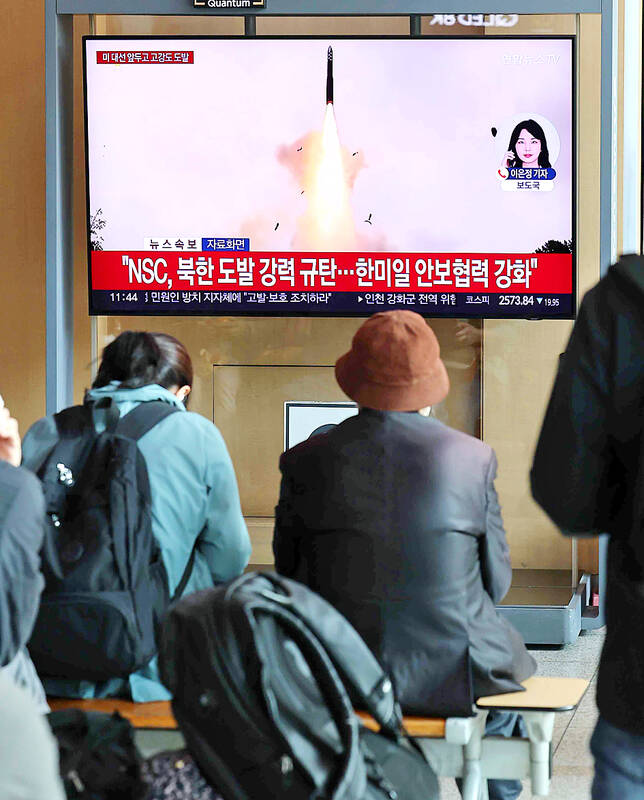
Photo: EPA-EFE
“The initial judgement so far is that [Pyongyang] may have test-fired a new solid-propelled long-range ballistic missile,” Seoul’s military said, adding that the missile had flown about 1,000km after being fired on a lofted trajectory — meaning up, not out.
Developing advanced solid-fuel missiles — which are quicker to launch and harder to detect and destroy in advance — has long been a goal for North Korean leader Kim Jong-un.
North Korea defended the sanctions-busting launch, calling it “an appropriate military action that fully meets the purpose of informing the rivals ... of our counteraction will,” the official Korean Central News Agency reported Kim as saying.
The test “updated the recent records of the strategic missile capability,” of North Korea, it said, with Kim vowing that his country “will never change its line of bolstering up its nuclear forces.”
Tokyo said that the “ICBM-class” missile had flown for longer than any other previously tested by the North, being airborne for about 86 minutes.
“We estimate that its flying altitude was the highest we have seen,” Japanese Minister of Defense Gen Nakatani told reporters.
Washington slammed the launch as “a flagrant violation of multiple UN Security Council resolutions,” US National Security Council spokesman Sean Savett said in a statement.
In Taipei, the Ministry of Foreign Affairs in a statement yesterday condemned North Korea’s firing of the ballistic missile.
It reiterated its serious concerns and strongly condemned North Korea’s “wanton actions,” which it said undermined regional peace and stability.
Taiwan would continue to work with like-minded countries to jointly safeguard freedom, openness, stability and prosperity in the Indo-Pacific region, it added.
The Chinese Ministry of Foreign Affairs said that it was “concerned about developments on the [Korean] peninsula,” and urged a “political resolution” to the issue.
Seoul, Washington and Tokyo — key regional security allies — would respond with joint military drills involving US strategic assets, Seoul said.
South Korean President Yoon Suk-yeol also said the country would “designate new independent sanctions” on the North and work with partners and the UN to penalize Pyongyang’s “habitual violations of [UN] Security Council resolutions.”
North Korea’s missile launch “seems to have been carried out to divert attention from international criticism of its troop deployment,” said Yang Moo-jin, president of the University of North Korean Studies in Seoul.
Seoul has long accused the North of sending weapons to help Moscow fight Kyiv, and alleged that Pyongyang has moved to deploy soldiers en mass in the wake of Kim’s signing of a mutual defense deal with Russian President Vladimir Putin in June.
The troop deployment poses a “significant security threat,” Seoul has said, with US Secretary of Defense Lloyd Austin on Wednesday calling on the North to pull their troops out.
South Korea’s military had warned lawmakers the day before that preparations were “nearly complete for an ICBM-class long-range missile” and that a launch could be aimed at testing the North’s atmospheric re-entry technology.
Seoul has warned that Russia might be providing new technology or expertise to Pyongyang in return for weapons and troops to help them fight Ukraine.
It is possible “Russia actually provided new technology for re-entering the atmosphere,” said Ahn Chan-il, a defector-turned-researcher who runs the World Institute for North Korea Studies.
However, it is more likely that yesterday’s test was a bid to distract from the troop deployment and get “the world’s attention ahead of the US presidential election” Ahn added.
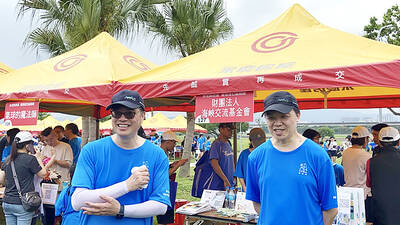
SECURITY: As China is ‘reshaping’ Hong Kong’s population, Taiwan must raise the eligibility threshold for applications from Hong Kongers, Chiu Chui-cheng said When Hong Kong and Macau citizens apply for residency in Taiwan, it would be under a new category that includes a “national security observation period,” Mainland Affairs Council (MAC) Minister Chiu Chui-cheng (邱垂正) said yesterday. President William Lai (賴清德) on March 13 announced 17 strategies to counter China’s aggression toward Taiwan, including incorporating national security considerations into the review process for residency applications from Hong Kong and Macau citizens. The situation in Hong Kong is constantly changing, Chiu said to media yesterday on the sidelines of the Taipei Technology Run hosted by the Taipei Neihu Technology Park Development Association. With
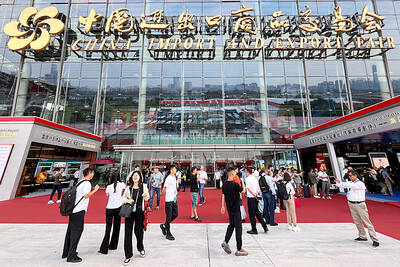
CARROT AND STICK: While unrelenting in its military threats, China attracted nearly 40,000 Taiwanese to over 400 business events last year Nearly 40,000 Taiwanese last year joined industry events in China, such as conferences and trade fairs, supported by the Chinese government, a study showed yesterday, as Beijing ramps up a charm offensive toward Taipei alongside military pressure. China has long taken a carrot-and-stick approach to Taiwan, threatening it with the prospect of military action while reaching out to those it believes are amenable to Beijing’s point of view. Taiwanese security officials are wary of what they see as Beijing’s influence campaigns to sway public opinion after Taipei and Beijing gradually resumed travel links halted by the COVID-19 pandemic, but the scale of
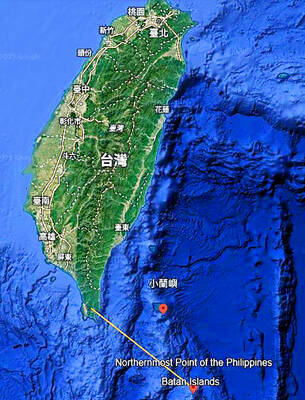
A US Marine Corps regiment equipped with Naval Strike Missiles (NSM) is set to participate in the upcoming Balikatan 25 exercise in the Luzon Strait, marking the system’s first-ever deployment in the Philippines. US and Philippine officials have separately confirmed that the Navy Marine Expeditionary Ship Interdiction System (NMESIS) — the mobile launch platform for the Naval Strike Missile — would take part in the joint exercise. The missiles are being deployed to “a strategic first island chain chokepoint” in the waters between Taiwan proper and the Philippines, US-based Naval News reported. “The Luzon Strait and Bashi Channel represent a critical access
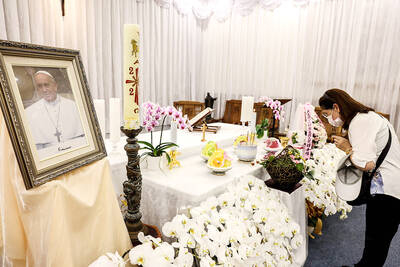
Pope Francis is be laid to rest on Saturday after lying in state for three days in St Peter’s Basilica, where the faithful are expected to flock to pay their respects to history’s first Latin American pontiff. The cardinals met yesterday in the Vatican’s synod hall to chart the next steps before a conclave begins to choose Francis’ successor, as condolences poured in from around the world. According to current norms, the conclave must begin between May 5 and 10. The cardinals set the funeral for Saturday at 10am in St Peter’s Square, to be celebrated by the dean of the College